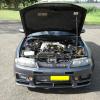R32gtr sputtering and stalling
Announcements
-
Similar Content
-
Latest Posts
-
Both windows operate normally while the engine is running but start to sag as soon as I switch off. Does anyone know of reasonably priced replacements or other brands that will fit?
-
Actually PowerFC is probably the easiest to get basic data from, it comes with a hand controller and display so you don't need to remember to pack a laptop every time you drive. It also has a PC based viewing/logging option if required. Nissan used consult on these because back in the mid 80s, ODB was just a glint in a standard's body's eyes. They switched to OBD shape around 2000 (my 2001 Cima had OBD shaped but not OBD compliant port) With the standard ECU there is a cable and software available to give basic data too, I think it is called Nissan Data Scan or s
-
Given by the sheer number of questions about offset, absolutely not. If you had the information formatted this way: Space from R34 GTT hub to outer arch = 100mm Space from R34 GTT inner hub to nearest suspension arm = 90mm. (making this up) Buying a wheel that was advertised as Enkei RPZ5 Diameter 18in Width 9 Distance to arch = 84mm Distance to suspension arm = 76mm 100% of people would know instantly if it fits. They would absolutely also know instantly how close it fits too, and no questions would need to be asked. You would know you would have 16mm from the guard and 14mm from the suspension arm.
-
Ah ok, for example for the apexi ecu I heard that it's pretty limited with the information it can give you. Also not sure why Nissan used the consult port over the obd2, what the idea there was.
-
Diagnosing with and without is mostly the same. You need to know, as Duncan asked, and what conditions. Car hot, cold, idling, driving, if while driving what rpms, is when you're varying, or is it when held constant. From there it's understanding what can be causing it. Starting with pretending all of the sensors are correct. Which means if it's going rich, why would it be thinking more air is going in than it is, and under what conditions. So things like if only when under boost, it could be be a loose intake piping joint. It's just understanding the system, and understanding when/how the problem occurs, and then if it's only occuring in specific scenarios, what can be causing it. ECU specifically, if it's aftermarket, it'll have software you can use, for the Skylines on factory ECU, there is Nissan Consult you can use. Most ECUs have a way to get data from them.
-








Recommended Posts
Create an account or sign in to comment
You need to be a member in order to leave a comment
Create an account
Sign up for a new account in our community. It's easy!
Register a new accountSign in
Already have an account? Sign in here.
Sign In Now